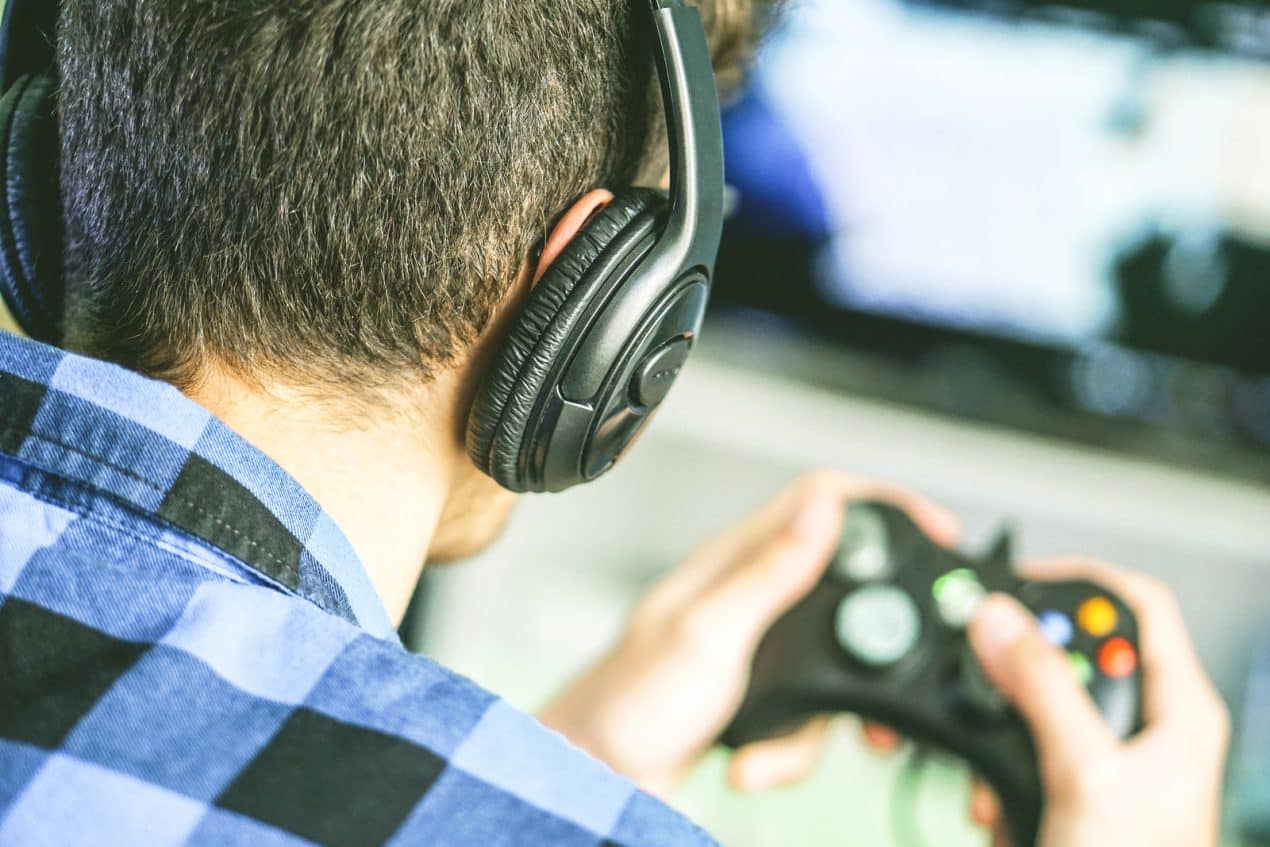There are both benefits and risks for autistic children and their use of screen time, writes Altogether Autism researcher Julie Peake.
These “benefits/risks” very generally fall in the cognitive and physical domains of wellbeing.
Health and wellness for all children requires adequate physical activity, healthy nutrition, good sleep habits and a nurturing social environment (Chassiakos et al 2016).
Current guidelines recommend the same screen time for both autistic and neurotypical children. Healthy plans for families that support a balance between screen time and other activities are recommended for those with and without autism.
What is screen time?
Screen time refers to the time spent watching TV or movies, playing games on handheld devices including phones, computers or gaming consoles. A distinction is usually made between using screens for entertainment and education purposes.
Different types of screen time
Active: Active screen time allows the person to interact with the media. For example, any games on phones or iPads/tablets through apps, or video games on the computer, XBox, Wii and PlayStation or other console.
Passive: Passive means it does not get the person to actively engage in the media. Passive use is watching an item such as watching television, movies, music videos or YouTube videos.
Educational: Educational screen time can be either active or passive and relates to the amount of learning which takes place during screen time.
Active educational screen time could be in the form of the many apps out there designed to develop a specific skill such as reading, comprehension or numeracy. There are also many games which give children opportunities to build confidence, creativity and problem solving skills.
Some games may unintentionally teach numeracy or literacy through instructions and game play and therefore count as educational. Some passively consumed TV shows and movies can also be educational, for example documentaries which expose children to nature, animals and different cultures which children may not be exposed to otherwise. Screen time which is not associated with learning is considered ‘just for entertainment value’.

Autistic people may be drawn to screens because they provide a repetitive and predictable interface that is easily customised to the specific interests of an individual.
Current recommendations
A report published by Family First New Zealand in 2015 states the following in regards to screen time. These guidelines are not specific to people on the autism spectrum and relate to entertainment use only and do not factor in screen time for educational purposes.
3-5 years ……………….0.5 – 1 hour/day
5-7 years ……………….1 – 1.5 hours/day
7-12 years ………………1 – 1.5 hours/day
12-15 years …………….1.5 – 2 hours/day
16+ ………………………2 hours/day
Rules and Routines
Rules – Things to consider
- The age of the child.
- What are they using screen time for?
- Is it passive or active consumption?
- How educational is the content?
- Explain the reason for the rule to the child in an age-appropriate way.
- Have guidelines about the material that can be accessed (eg check for violent and inappropriate language).
- Consider the time of access to screens (i.e. limit screens before bed, not to be used in bedrooms or during eating).
Routines – Establish routines around rules
- It may be helpful to use a visual aid such as a timer to show how much screen time your child has left.
- Remind the child before time is up (e.g. five minutes left, one minute left).
- Reward appropriate behaviour (e.g. turning the TV off when the timer goes off means getting to play cards with a parent, going for a walk, or some other activity that interests the child – but don’t reward with more screen time!).
- Develop a list of alternative activities – this could be a visual list of activities to pick from such as after tablet time outside play time (use this list to help with identify rewards for appropriate behaviour).
- Make sure you child is getting enough exercise, social interactions and other developmental aspects that may be hindered by screen time.
- Be consistent with rules and routines.
- Role-model good behaviour in regards to screen time (i.e. show the child you are able to switch off screens too).
What does the research say?
Autistic people may be drawn to screens because they provide a repetitive and predictable interface that is easily customised to the specific interests of an individual. Digital media provides the user with visual and auditory engagement that stimulates neural pathways. For many autistic children and adolescents these neural pathways are not always stimulated during face to face interactions. Face to face interactions can elicit anxiety for many autistic children and young people so it becomes understandable why digital media devices may be preferred (Mazurak et al, 2012; McMullan et al, 2016).
Most research suggests that children and adolescents on the autism spectrum spend more time on video games and computers than their neurotypical (non-autistic) peers (Mazurek et al., 2012; 2013; Kuo et al., 2014; MacMullin et al, 2016).
In contrast, autistic children spend less time using social media or socially interactive electronically based games (Mazurek & Wenstrup, 2012). While there are identified benefits of using digital and social media there are a number of risks as well.
The benefits in summary are:
- creating learning opportunities
- increasing knowledge
- increasing opportunities for social contact and support.
The risks include:
- negative effects on sleep
- problems with attention and learning
- higher incidence of obesity and depression
- exposure to inaccurate, inappropriate and/or unsafe content and people
- compromised privacy and confidentiality (Chassiakos et al., 2016; Westby, 2016).
A very recent study by Hedges and others (2018) examined how autistic secondary students use technology in supportive ways. This was a descriptive study using self-reports from 472 adolescents on the autism spectrum. These young people revealed they were using a variety of forms of technology in numerous ways across home and school settings to support learning, help them stay organised, communicate, reduce stress, increase their independence and increase their social opportunities.
McLeod et al (2018) suggest that the rapid adoption and use of technology makes it difficult for evidence-based research to keep pace and identify what is most helpful for the cognitive and physical domains of wellbeing.
It is likely that over the next few years the evidence-base will increase as more research is carried out and published. Until more is known from a research perspective, following screen time guidelines and having family rules and routines is the suggested option.
- Julie Peake, B Soc. Sci (Hons) (Psychology and Sociology), Dip Social Work, PG Dip SSS is an Altogether Autism researcher.
References
Chassiakos, Y., Radesky, J., Christakis, D., Moreno, M., Cross, C. (2016). Child and adolescents and digital media. Pediatrics, volume 138, 5, November 2016.
Family First (2015). We need to talk – Screen time in NZ, Media Use: An emerging factor in child and adolescent health.
Hedges, S., Odom, S., Hume, K., & Sam, A. (2018). Technology use as a support tool by secondary students with autism. Autism, vol 22 (1) 70-79.
Kuo, M., Orsmond, G., Coster, W., & Cohn, E. (2014). Media use among adolescents with autism spectrum disorder. Autism, 18 (8) 914-923.
MacMullin, J., Lunsky, Y., & Weiss, J. (2016). Plugged in: Electronics use in youth and young adults with autism spectrum disorder. Autism, vol 20 (I) 45-54.
Mazurek, M., & Wenstrup, C. (2012). Television, video game and social media use among children with ASD and typically developing siblings. Journal of Autism and Developmental Disorders 43:1258-1271.
Mazurek, M., & Engelhardt, C. (2013). Video Game Use in Boys with Autism Spectrum Disorder, ADHD, or Typical development. Pediatrics Volume 132, Number 2, August 2013.
Montes, G (2016). Children with autism spectrum disorder and screen time: Results from a large, nationally representative US study. Academic Pediatrics, 16: 122-128.
McLeod, G., Sidhu, S., Ceranoglu, T. (2018). Electronic Screen Media Use in Youth with Autism Spectrum Disorder. Child and Adolescent Psychiatric, 27, 203-219.
Stiller, A & Mößle, T. (2018). Media Use Among Children and Adolescents with Autism Spectrum Disorder: a Systematic Review. Review Journal of Autism and Developmental Disorders, September 2018, Volume 5, Issue 3, pp 227- 246.
Westby, C. (2016). Why children with autism are more at risk for the negative effects of screen time.



